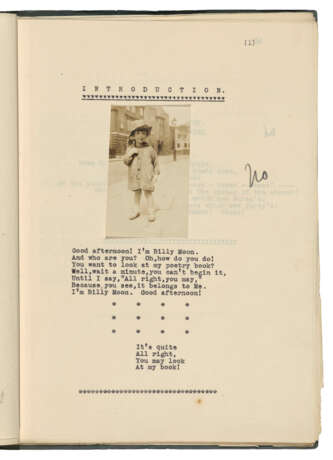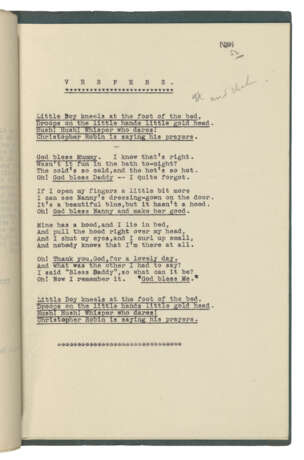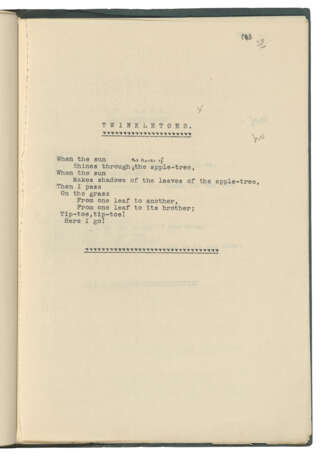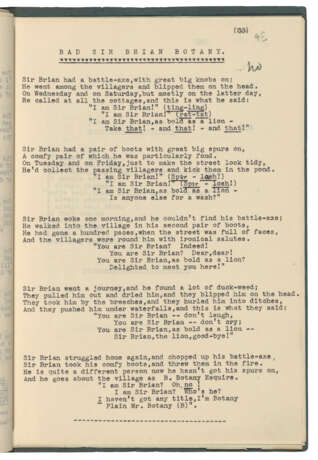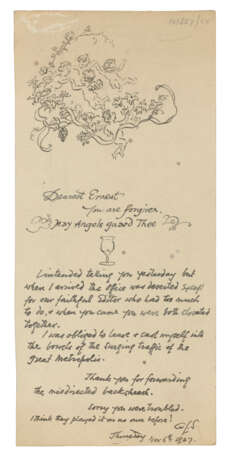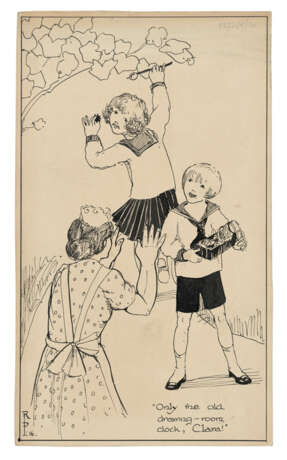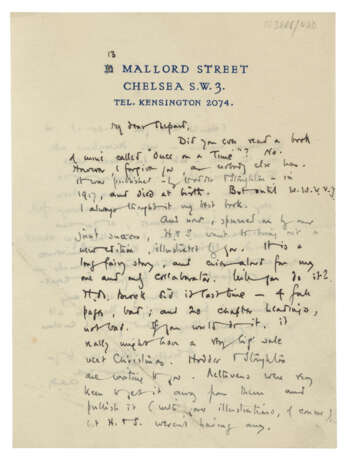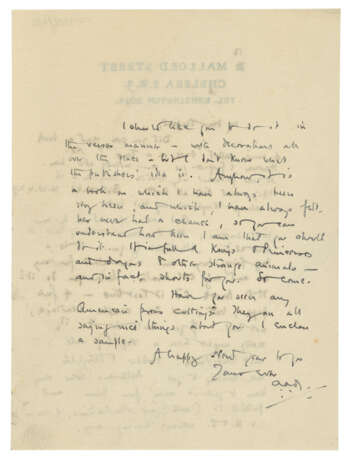ID 1249745
Lot 103 | A.A. Milne (1882-1956)
Valeur estimée
£ 10 000 – 15 000
Annotated typescript, an early draft of When we were Very Young with autograph emendations, n.d. [late 1923 or early 1924]
33 pages, 260 x 203mm, two of the leaves featuring an unpublished poem, one with an original photograph of Christopher Robin pasted down, a few autograph emendations in ink, ‘WHEN WE WERE VERY YOUNG’ supplied in autograph on a title page featuring Milne’s address on Mallord Street, with further pencil annotations in another hand, presumably the publisher’s, four leaves present in duplicate. In two blue paper folders, one titled in autograph and signed.
Provenance:
(1) Apparently from the papers of E.H. Shepard (1879-1976); included with the present lot are two letters to Shepard [described below], dated c.1924 and 1947.
(2) Sotheby’s New York, 15 December 1986, lot 69.
An early draft for When we were Very Young, featuring an unpublished prefatory poem illustrated with a hitherto-unseen photograph of the young Christopher Robin. Apparently from the papers of E.H. Shepard. The typescript contains twenty-three poems in total: 22 of these number among the 44 that appeared in When we were Very Young, first published by Methuen on 6 November 1924, including much-loved poems such as ‘Vespers’ and ‘Hoppity’. The introductory poem appears to be unpublished and is illustrated with an original photograph of Christopher Robin Milne wearing his now-famous floppy hat and short coat, which is not reproduced in the book. The poem, which opens ‘Good afternoon. I'm Billy Moon./ And who are you? Oh, how do you do!’ and closes ‘It’s quite/ All right,/ You may look/ At my book!, was replaced in the published edition with a longer prose preface, ‘Just before we begin’. The pagination and the order of the poems – often corrected in pencil here, with annotations apparently relating to the selection of poems for publication (‘No’, ‘Too old’, ‘rather old’, ‘used’) – does not correspond with the published edition; the poems were evidently rearranged and revised before they were published with the new preface. There are a number of textual variations from the first edition: the verbs in ‘The Wrong House’ are here entirely in the past tense (the published version employs the present tense); Bad Sir Brian Botany's boots are here described as ‘A comfy pair of which he was particularly fond’, later revised by Milne to ‘A fighting pair’; the stanzas of ‘Nursery Chairs’ were later rearranged; and a line was added to ‘The Three Foxes’.
As a young boy, Christopher Robin Milne was referred to by his family as ‘Billy Moon’, a combination of an early nickname, Billy, and his childhood mispronunciation of Milne. The prefatory poem that opens this early draft typescript for When we were Very Young beneath a pasted-in photograph of the young Christopher Robin was perhaps considered too personal for inclusion in the published edition. When we were Very Young was a huge success when it appeared in 1924 and was acclaimed in The Times as 'the greatest children's book since Alice'.
[with:] A.A. Milne. Autograph letter signed (‘A.A.M.’) to [Ernest Howard] Shepard, 13 Mallord Street, Chelsea, n.d. [1925 or earlier]. 2 pages, 151 x 113m. Asking Shepard to illustrate a new edition of Once on a Time and giving him an idea of what he had in mind for the book: ‘Did you ever read a book of mine called “Once on a Time”? No. However, I forgive you, as nobody else has. It was published – by Hodder & Stoughton – in 1917, and died at birth. But until W[hen] W[e] W[ere] V[ery] Y[oung] I always thought it my best book. And now, spurred on by our joint success, H&S want to bring out a new edition, illustrated by you. It is a long fairy story, and cries out for my one and only collaborator. Will you do it?’;
[and:] George Loraine Stampa (1875-1951). Illustrated autograph letter signed (‘G.L.S’) to Ernest [Howard Shepard], n.p., 6 November 1947. One page, 193 x 89mm, partial ink drawing on the recto. A light-hearted letter offering his forgiveness, noting that they missed seeing one another in the [?Punch] offices, and thanking him for forwarding the ‘misdirected backsheets’;
[and:] An ink illustration of two young children and a maid, titled ‘only the old drawing-room clock, Clara’, signed and dated ‘R.P. 16’.
| Artiste: | Alan Alexander Milne (1882 - 1956) |
|---|---|
| Lieu d'origine: | Angleterre, Europe du Nord, Europe, Royaume-Uni |
| Catégorie maison de vente aux enchères: | Lettres, documents et manuscrits, Livres et manuscrits |
| Artiste: | Alan Alexander Milne (1882 - 1956) |
|---|---|
| Lieu d'origine: | Angleterre, Europe du Nord, Europe, Royaume-Uni |
| Catégorie maison de vente aux enchères: | Lettres, documents et manuscrits, Livres et manuscrits |
| Adresse de l'enchère |
CHRISTIE'S 8 King Street, St. James's SW1Y 6QT London Royaume-Uni | |
|---|---|---|
| Aperçu |
| |
| Téléphone | +44 (0)20 7839 9060 | |
| Commission | see on Website | |
| Conditions d'utilisation | Conditions d'utilisation |
